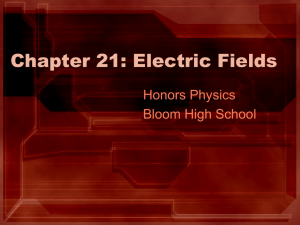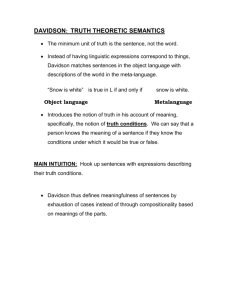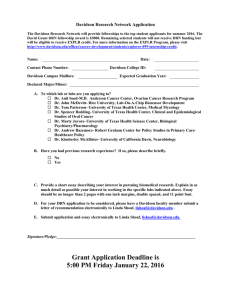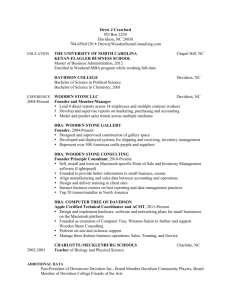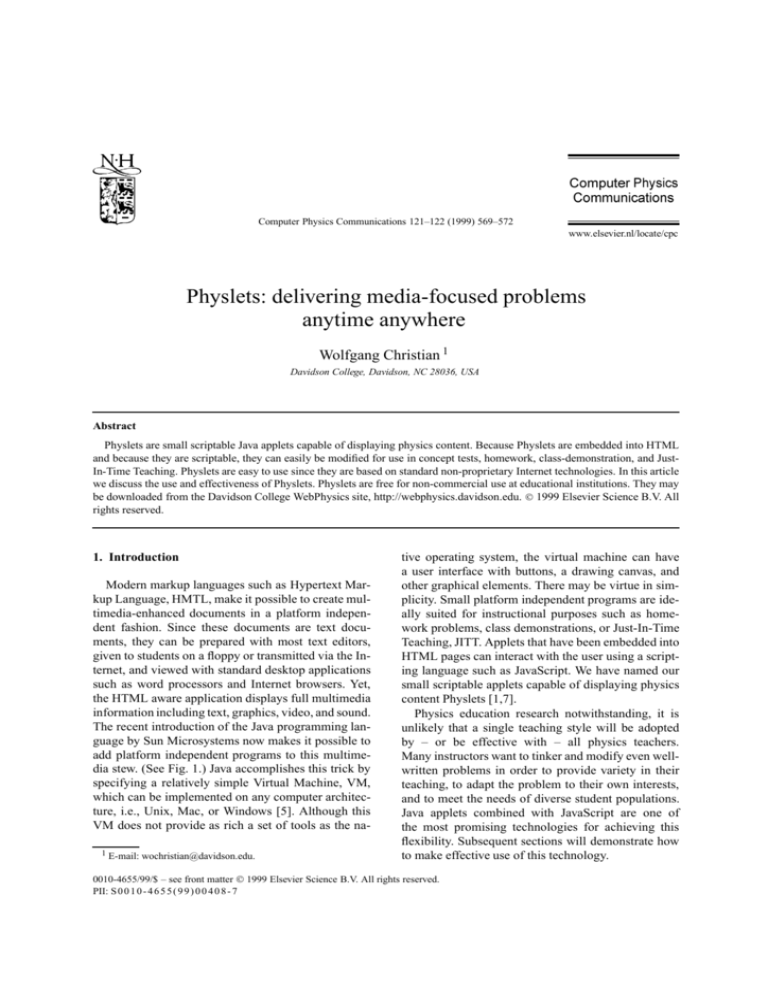
Computer Physics Communications 121–122 (1999) 569–572
www.elsevier.nl/locate/cpc
Physlets: delivering media-focused problems
anytime anywhere
Wolfgang Christian 1
Davidson College, Davidson, NC 28036, USA
Abstract
Physlets are small scriptable Java applets capable of displaying physics content. Because Physlets are embedded into HTML
and because they are scriptable, they can easily be modified for use in concept tests, homework, class-demonstration, and JustIn-Time Teaching. Physlets are easy to use since they are based on standard non-proprietary Internet technologies. In this article
we discuss the use and effectiveness of Physlets. Physlets are free for non-commercial use at educational institutions. They may
be downloaded from the Davidson College WebPhysics site, http://webphysics.davidson.edu. 1999 Elsevier Science B.V. All
rights reserved.
1. Introduction
Modern markup languages such as Hypertext Markup Language, HMTL, make it possible to create multimedia-enhanced documents in a platform independent fashion. Since these documents are text documents, they can be prepared with most text editors,
given to students on a floppy or transmitted via the Internet, and viewed with standard desktop applications
such as word processors and Internet browsers. Yet,
the HTML aware application displays full multimedia
information including text, graphics, video, and sound.
The recent introduction of the Java programming language by Sun Microsystems now makes it possible to
add platform independent programs to this multimedia stew. (See Fig. 1.) Java accomplishes this trick by
specifying a relatively simple Virtual Machine, VM,
which can be implemented on any computer architecture, i.e., Unix, Mac, or Windows [5]. Although this
VM does not provide as rich a set of tools as the na1 E-mail: wochristian@davidson.edu.
tive operating system, the virtual machine can have
a user interface with buttons, a drawing canvas, and
other graphical elements. There may be virtue in simplicity. Small platform independent programs are ideally suited for instructional purposes such as homework problems, class demonstrations, or Just-In-Time
Teaching, JITT. Applets that have been embedded into
HTML pages can interact with the user using a scripting language such as JavaScript. We have named our
small scriptable applets capable of displaying physics
content Physlets [1,7].
Physics education research notwithstanding, it is
unlikely that a single teaching style will be adopted
by – or be effective with – all physics teachers.
Many instructors want to tinker and modify even wellwritten problems in order to provide variety in their
teaching, to adapt the problem to their own interests,
and to meet the needs of diverse student populations.
Java applets combined with JavaScript are one of
the most promising technologies for achieving this
flexibility. Subsequent sections will demonstrate how
to make effective use of this technology.
0010-4655/99/$ – see front matter 1999 Elsevier Science B.V. All rights reserved.
PII: S 0 0 1 0 - 4 6 5 5 ( 9 9 ) 0 0 4 0 8 - 7
570
W. Christian / Computer Physics Communications 121–122 (1999) 569–572
Fig. 1. A typical media-focused Physlet problem as seen on Windows 95 with Netscape Navigator.
2. Pedagogy
A technology should not be used in the classroom if the pedagogy it produces is not sound. It is
useful to distinguish between media-enhanced problems where multimedia is used to present what is described in the text and media-focused problems where
the multimedia presentation contains information required for solving the problem. Multimedia-focused
problems are fundamentally different from traditional
physics problems and Physlets are ideally suited for
these types of problems. A traditional projectile problem states the initial velocity and launch angle and
asks the student to find the speed at the maximum
height. It may be media-enhanced by embedding the
animation in the text. This same problem could be a
media-focused problem, see Fig. 1, if numbers were
not given in the text. Students are then required to observe the motion, apply appropriate physics concepts,
and make measurements before solving the problem.
Such an approach is remarkably different than typical
novice strategies where students attempt to mathematically analyze a problem before qualitatively describing it (an approach we as teachers often call “plugand-chug” and characterized by the lack of conceptual
thought during the problem solving process). Requiring students to consider the problem qualitatively is
believed to have a positive influence on students’ problem solving skills and conceptual understanding [3,4].
Fig. 2. A simulated solar system with one non-physical planet.
Consider the screen shot shown in Fig. 2. The
student is asked to find the “planet” that does not obey
Kepler’s laws. How does a student solve this problem?
The student must observe the motion and recognize
that the ratio of the square of the orbital period to the
cube of the orbital radius is required for a number of
planets. Numerous orbit parameters must be measured
W. Christian / Computer Physics Communications 121–122 (1999) 569–572
and it is unlikely that the first measurements will yield
anything unexpected. In fact, the orbit that “looks”
most unphysical is the outer orbit because the planet
moves very slowly. The unphysical innermost planet
zips along at too slow a rate. This visual representation
of abstract formulas is surprising to students.
How is the Physlet problem different from a similar
traditional problem? In a traditional problem, the
student is given an orbital parameter for a satellite
and is given another satellite for comparison, thereby
suggesting the path to the solution. In comparison,
the multimedia-focused problem requires observation
and conceptual reasoning before quantitative analysis.
The idea that the outer planets move very slowly in
comparison to the inner planets in reinforced by visual
observation.
Multimedia-focused problems are believed to be
more “real-world-like” than traditional textbook problems. Upon first encountering multimedia-focused
problems, many people comment that “they are like
virtual laboratories”. As in an experiment, students
must determine what is required to solve the problem
before attempting a solution. Likewise, the answer depends on the method of solution and experimental error. Instructors can use Physlets to ask questions indicative of those encountered in actual laboratory situations.
As another example, consider constant acceleration.
The student is first shown a ball moving up with a constant downward acceleration. Later she is shown a ball
moving down with a constant downward acceleration.
Students are asked to determine the acceleration for
both objects. Simply watching the motion of the ball
and the time ought to allow the student to give an order
of magnitude estimate of the answer. But physics education research has shown that students have a great
deal of difficulty in not associating the direction of motion with the direction of acceleration (or force) [2].
Students may not only be asked how to solve a
problem, they may also be asked to solve the problem
with a small experimental uncertainty. In our experience, students who are well-versed in problem solving sometimes have little understanding of experimental error. When a constant acceleration problem was
delivered on a homework assignment at North Carolina State University, NCSU, one insightful student
remarked that the calculated acceleration was different
depending on which equation of motion she used. The
571
different results were a result of experimental error,
since position cannot be measured to better than one
pixel on a computer monitor. Taking the ratio of Dx to
Dt for one time step is likely to produce unacceptable
error. Hopefully this led the student to a greater understanding of experimental error. Unfortunately, some
students believe that such exercises requiring observation, qualitative reasoning, and measurement should
not be part of the lecture course, but left for the laboratory.
3. Student attitudes
There is ample evidence to support the conclusion that conceptual media-focused problems require
higher order reasoning and are every bit as difficult
as problems requiring intensive numerical calculations. Students accustomed to solving traditional problems simply may not apply the same resources to
multimedia-focused problems.
A recent study by Aaron Titus at North Carolina
State University found that students believed Physlet
problems to be more difficult than traditional textbook
problems covering similar topics [6]. A few examples
of student responses to a survey about the effectiveness
of Physlets are listed below. Spelling and grammatical
errors have not been changed in order to accurately
reflect students’ responses.
• Because we are not just given numbers to play with
in the calculator or put in a formula when you have
an animation you got to figure out what numbers
to use. I guess that is good for us, helping us to
understand problems closer to real life situations.
• The [traditional] problems deal with the basic principles of physics. Most of the time they involve
plug-and-chug. You just have to know what formula
to use
• They are more difficult because you do not have the
numbers right in front of you. Instead they are in the
form of the objects moving, and it is hard to get the
real numbers.
• It’s more difficult to observe velocity, acceleration,
etc, and then calculate other properties of the
animation from your observations.
• Animation is more difficult because in addition to
solving the problem you may have to determine
time, displacement, velocity, etc. . . by viewing,
572
W. Christian / Computer Physics Communications 121–122 (1999) 569–572
whereas in a standard problem that information has
to be given. Also, since you are not given all the
pieces of information needed to work the problem
(you have to get information from viewing) it is
difficult to know what you are looking for, i.e. what
you need to be able to solve the problem.
• You have to obtain data, it is not merely given to you
for “plug-and-chug”. This is sometimes difficult.
Also, it is harder to define what method/formulas
you will be utilizing in the problem.
Although some students at NC State may not have
been exposed to Physlets on a regular enough basis to
be comfortable with the technology, similar comments
were obtained in interviews at Davidson College.
Davidson students were shown how to use Physlets
in laboratory and given weekly media-focused assignments in class, yet 84% felt that Physlet-based problems were more difficult than traditional problems.
4. Conclusion
We are continuing to investigate the impact of
multimedia-focused problems using Physlets on students’ problem solving skills and conceptual understanding. At first, students seem to have greater difficulty solving these problems than similar traditional problems where necessary information is given
in the text of the question. It is likely that students are accustomed to a “plug-and-chug” approach
rather than qualitatively reasoning. However incorporating multimedia-focused problems using Physlets
into daily instruction will likely help improve students’ impressions of these problems and help them
learn the problem solving strategy required for solving them. Increased attention to qualitative reasoning
may also have an impact on students’ conceptual understanding.
Our goal as curriculum designers and teachers is not
to impress, but to meet the needs of learners. Through
the development of multimedia-focused problems using Physlets, we believe we’ve found a powerful tool
to challenge students’ conceptual understanding of
physics as well as their approach to problem solving.
References
[1] W. Christian, A. Titus, Developing Web-based curricula using
Java applets, Comput. Phys. 12 (1998) 227–232.
[2] D. Hestenes, M. Wells, G. Swackhamer, Force concept inventory, The Physics Teacher 30 (1992) 141–158.
[3] J.H. Larkin, J. McDermott, D.P. Simon, H.A. Simon, Expert and
novice performance in solving physics problems, Science 208
(1980) 1342–1355.
[4] W.J. Leonard, R.J. Dufresne, J.P. Mestre, Using qualitative
problem solving strategies to highlight the role of conceptual
knowledge in solving problems, Amer. J. Phys. 64 (1996) 1495–
1503.
[5] J. Meyer, T. Downing, Java Virtual Machine (O’Reilly &
Associates, Sebastopol, CA, 1997).
[6] A. Titus, Integrating video and animation with physics problem
solving exercises on the World Wide Web, Ph.D. dissertation,
North Carolina State University, Raleigh, NC (1998).
[7] There are currently 24 Physlets available on the Davidson
College Physics server, http://webphysics.davidson.edu/applets/
applets.html. Physics educators are encouraged to download
these applets and to script their own problems.

